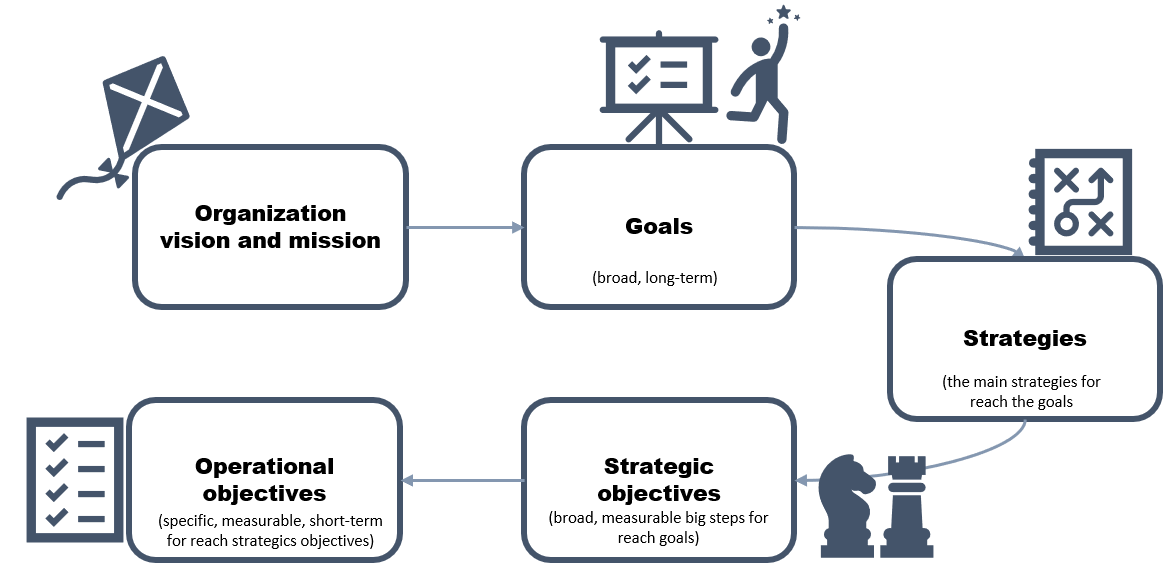You know what are the impacts of Cloud adoption on your governance and you start with building your Cloud principles, what next?
An important phase at this point it’s the alignment of company business goals with Cloud services. If the Cloud objectives are not aligned with real company needs, Cloud service adoption can be a step backwards in terms of cost and efficiency rather than a qualitative advantage. Let better distingue the difference between goals and objectives.
-
Goals are general guidelines that explain what you want to archives in your company. They are usually long-term and express global visions such as “give to the customers a better experience”, “security-first”, “reducing the time to market”, and others;
-
Objectives define strategies or implementation steps to attain the identified goals. Objectives are specific, measurable, and have a completion date. So, from previous goals examples, we can have these objectives such as “design a new user interface”, “define security policies and controls”.
So, as we have seen, Cloud services objectives are specific and measurable and they must be followed to reach the strategic objectives of the company business. Cloud’s objectives are generally a subset of IT objectives.

Align Cloud services with goals and objectives, and use or adapt them to respond to factors of strategy change, to respond to stakeholders, operational changes.
Factors influencing strategy changes can be internal or external to the business organization. Some can be customer inputs, new technologies, new laws, or internal factors from teams new skills or dissatisfaction. Are we going in a good direction? should we change something?
For example, the company doesn’t want to invest in IT CapEx, it’s not their core business to manage a CED infrastructure, so factors of change can be the need for cost reduction and the availability of newly available technology. So, a simplified example of the alignment can be the following:
- Goals
- Take advantage of new technology for cost reduction and management of CED infrastructure.
- Strategies
- Migrate all services to a Public Cloud computing environment for taking advantage of the pay for use model.
- Strategic objectives
- Organize the migration in two phases. The first objective is to migrate 30% of business services to the public Cloud in the first semester of this year;
- In the second phase, migrate the remaining services by the end of the year.
- Operational objectives
- Configure the public cloud infrastructure by February;
- Prepare applications X, Y, Z for migration;
- Execute migration of X, Y, Z applications;
- and more.
What about factors of operational changes? These kinds of factors are generally connected to operational problems, events or anticipated risks. For example, customer users can encounter poor application performance, a security violation like a data breach or a simple down of servers, these are considerating factors of operational change.
We can create a list of problems and risks known to the IT department and for these problems and risks define objectives for resolution and mitigation that satisfy the factors of changes. Of course, not all factors of change can be related to Cloud. Some examples can be the following:
A factor of operational change: the business core application has a performance degrade during office time.
- Objectives:
- Change the application architecture for adopting a horizontal scaling model;
- Use CDN for static resources;
- Switch some synchronous operations to asynchronous.
Conclusion
Do not just start some virtual machine or fancy services on the Cloud. It’s ok for the experimentation period, but running business core services without a strategy, in the long run, can hurt in terms of cost and efficiency.
Identify organization goals and strategic objectives, and align Cloud services to them. Technologies must serve the company business and not vice versa.
References
- Fulton, Lita. Cloud Governance and Management Made Simple: Practical Step-by-Step Guide for Small and Mid-Sized Organizations
